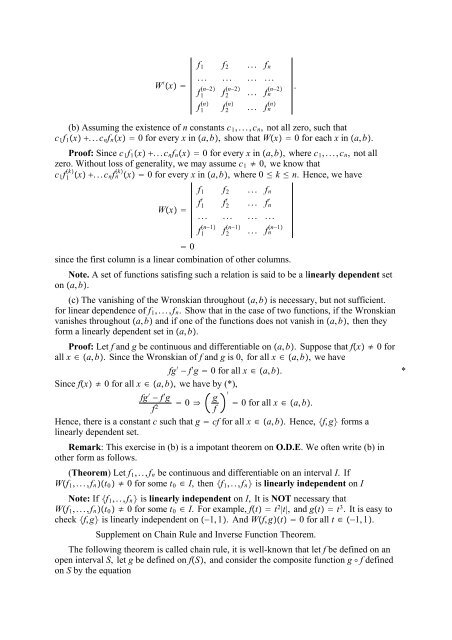The Real And Complex Number Systems
The Real And Complex Number Systems
The Real And Complex Number Systems
Create successful ePaper yourself
Turn your PDF publications into a flip-book with our unique Google optimized e-Paper software.
W x <br />
f 1 f 2 ... f n<br />
... ... ... ...<br />
f 1<br />
n2<br />
f 1<br />
n<br />
f 2<br />
n2<br />
f 2<br />
n<br />
... f n<br />
n2<br />
... f n<br />
n<br />
.<br />
(b) Assuming the existence of n constants c 1 ,...,c n , not all zero, such that<br />
c 1 f 1 x ...c n f n x 0 for every x in a, b, show that Wx 0 for each x in a, b.<br />
Proof: Since c 1 f 1 x ...c n f n x 0 for every x in a, b, wherec 1 ,...,c n , not all<br />
zero. Without loss of generality, we may assume c 1 0, we know that<br />
c 1 f k 1 x ...c n f k n x 0 for every x in a, b, where 0 k n. Hence, we have<br />
Wx <br />
f 1 f 2 ... f n<br />
f 1 f 2 ... f<br />
n<br />
... ... ... ...<br />
f 1<br />
n1<br />
f 2<br />
n1<br />
... f n<br />
n1<br />
0<br />
since the first column is a linear combination of other columns.<br />
Note. A set of functions satisfing such a relation is said to be a linearly dependent set<br />
on a, b.<br />
(c) <strong>The</strong> vanishing of the Wronskian throughout a, b is necessary, but not sufficient.<br />
for linear dependence of f 1 ,...,f n . Show that in the case of two functions, if the Wronskian<br />
vanishes throughout a, b and if one of the functions does not vanish in a, b, then they<br />
form a linearly dependent set in a, b.<br />
Proof: Let f and g be continuous and differentiable on a, b. Suppose that fx 0for<br />
all x a, b. Since the Wronskian of f and g is 0, for all x a, b, wehave<br />
fg f g 0 for all x a, b. *<br />
Since fx 0 for all x a, b, wehaveby(*),<br />
fg f g<br />
0 g <br />
0 for all x a, b.<br />
f 2 f<br />
Hence, there is a constant c such that g cf for all x a, b. Hence, f, g forms a<br />
linearly dependent set.<br />
Remark: This exercise in (b) is a impotant theorem on O.D.E. We often write (b) in<br />
other form as follows.<br />
(<strong>The</strong>orem) Letf 1 ,..,f n be continuous and differentiable on an interval I. If<br />
Wf 1 ,...,f n t 0 0forsomet 0 I, then f 1 ,..,f n is linearly independent on I<br />
Note: If f 1 ,..,f n is linearly independent on I, ItisNOT necessary that<br />
Wf 1 ,...,f n t 0 0forsomet 0 I. For example, ft t 2 |t|, andgt t 3 . It is easy to<br />
check f, g is linearly independent on 1, 1. <strong>And</strong>Wf, gt 0 for all t 1, 1.<br />
Supplement on Chain Rule and Inverse Function <strong>The</strong>orem.<br />
<strong>The</strong> following theorem is called chain rule, it is well-known that let f be defined on an<br />
open interval S, letg be defined on fS, and consider the composite function g f defined<br />
on S by the equation
















